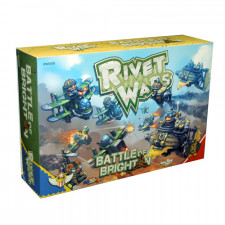Rivet Wars: Battle of Brighton Review
on Jun 3, 2015
Once upon a time there was an obscure web site known only to those with the patience to paint seventeen layers of color on Tomb Kings or Legiones Astartes, and then Cool Mini or Not began kickstarting miniature games. Two years later, they are probably hiring washed-up day traders from Stratton Oakmont to help rake their money in for them after many successful Kickstarters. One of their first forays into this arena was Rivet Wars, a skirmish game set in a steampunk Great War realm, and the Battle of Brighton expansion takes this game to the skies.
The Allies and Blight each get five aircraft, an ace, a weapon plug and an anti-aircraft gun. All of the above follow Rivet Wars’ well-crafted asymmetry, granting a balanced whole made up of imbalanced parts to each side and challenging the player to determine their best use. Two scout aircraft, two air superiority fighters and a bomber per side, and the AA units follow their side’s construction philosophy with the Allies gaining another tracked vehicle and the Blight another walker.
An Air Rules book, stat, action and mission cards round out the package along with the set’s most innovative feature: clear plastic stands for the aircraft with a plus-shaped base that fits along the grid lines of the game board, allowing ground figures to occupy the four squares directly beneath the plane. Take heed, English Workshops Where Games Are Made: fitting troops under your fliers is more important than sculpting shrubbery beneath it. Well done, CMoN.
Brighton buyers can now make use of all stats on their core units, since CMoN planned for air wars in advance and gave certain units in the base game anti-air attack values and some, but not all, of the aircraft can return fire to ground-based foes. Unit variance necessitates planning your reinforcements for the scenario at hand, just like pure land-based battles, and Brighton introduces new challenges for battlefield commanders via the weaponry of the day, aircraft facing and the dynamics of flight.
Aircraft are hard to kill because nearly all Rivet Wars ground units only roll a single die against air power, with the game’s standard 33% chance to hit, and it can be risky to aim skyward with a tank bearing down on you. Combine their survival chance with air units’ low points cost and the appeal of getting planes over the trench lines, and unwary commanders will soon find the skies filled with aircraft and the ground swarming with infantry and vehicles. Visually appealing, yes, at the cost of turns taking much longer to complete and a Rivet Wars battle lasting as long as World War One itself.
Air weaponry isn’t omni-directional. Unlike ground units, aircraft can only shoot air targets directly in line with the nose of their plane and ground targets to either side of that grid line, so proper flight planning is required to keep aircraft from becoming expensive tourists buzzing around above the war.
Aircraft stay airborne by either being lighter than air or causing air to move over their lifting surfaces faster than under them, and Brighton brings physics into the Eastern Front to varying degrees for each aircraft, commensurate with their design. The Blight’s smaller Zeppelins can sit still if they choose, but fixed wing aircraft on both sides have to stay moving to stay airborne, represented in the game by a minimum move value. Aircraft can turn ninety degrees once at any time during their turn, but must move forward by their minimum value, a mechanic which creates thematic dogfights, strafing runs, and flights to nowhere by inexperienced pilots.
Scenarios included in the rule book bring the air war to life. These battles also illustrate one of the oldest maxims of war: fancy toys are handy, but boots on the ground win a war. Unless specifically stated, air power contributes little to victory conditions since they can’t capture objectives and most Rivet Wars combat is objective-based, so the sooner players recognize the role of air power and use it accordingly, the better their Rivet Wars experience will be.
As with all Rivet Wars products, the minis are spectacular - full of detail and expert craftsmanship. Character or weapon plugs offer customization possibilities galore. Initial battles involve a crowded map full of novice pilots circling around shouting curses at each other while riflemen plink at them from below, but once players master their stick-and-rudder play style and learn where they fit in the order of battle, aircraft integrate seamlessly into the Rivet Wars system, adding a thrilling third dimension to the Eastern Front.

 Customer Support
Customer Support  Subscribe
Subscribe 




 Account
Account  Wishlist
Wishlist 

